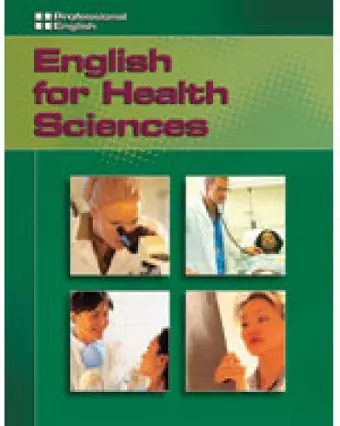English for Health Sciences: Professional English
Hector Sanchez author Ivor Williams author O'Brien author Kristin Johannsen author Milner author
Format:Paperback
Publisher:Cengage Learning, Inc
Published:12th May '06
Should be back in stock very soon

The purpose of English for Health Sciences is to empower students with the language and life skills they need to carry out their career goals. To this end it provides ample opportunities for students to build awareness and practice the language in real-life scenarios. Its integrated skills approach develops the student's self-confidence to survive and succeed in professional and social encounters within an English-speaking global community. Health Science majors will immediately be motivated by the opportunity to prepare for their future careers by practicing their English language skills in the following job-related scenarios. Diagnosing Putting a patient at ease with small talk, taking a medical history, asking open-ended questions, presenting a case, and explaining medical tests and procedures to a patient Treating a patient Giving advice, explaining a case to a relative, explaining causes and treatments, giving discharge instructions, and calming people down Dealing with critical patients Describing and identifying causes of pain, recognizing and adopting supportive intonation, presenting a case in lay as well as medical terms, and breaking bad news Assisting in rehabilitation and long-term care Examining a non-verbal patient, communicating with the next of kin, explaining test results to patient and relatives, explaining the conditions of long-term care, and giving instructions for physical therapy Referring a patient Calling in a specialist, referring a patient to another doctor for tests and/or treatment, and giving post-operative advice
UNIT 1. MAKING THE DIAGNOSIS. Lesson 1. So, what can I do for you? Lesson 2. Taking a medical history. Lesson 3. I'd like to examine you. Lesson 4. What's the preliminary diagnosis? Lesson 5. Let me explain your diet. Lesson 6. To put it more simply. Team Project 1. UNIT 2. WORKING UNDER PRESSURE. Lesson 1. If you are not sure, ask. Lesson 2. He'll be fine, Mr Slenkovich. Lesson 3. Has he ever fainted before? Lesson 4. I'd like to ask you a few questions. Lesson 5. We need to take a sample. Lesson 6. Can I explain the procedure? Team Project 2. UNIT 3. BREAKING BAD NEWS. Lesson 1. Can you describe the pain? Lesson 2. It's how you say it. Lesson 3. It's getting you down, isn't it? Lesson 4. We need a psychiatric evaluation. Lesson 5. It might be multiple sclerosis. Lesson 6. Breaking bad news. Team Project 3. UNIT 4. CALLING IN THE STROKE TEAM. Lesson 1. She can hardly speak. Lesson 2. How many fingers can you see? Lesson 3. We need to run a few more tests. Lesson 4. What medication would you prescribe? Lesson 5. Let's decide your rehabilitation plan. Lesson 6. I'm going to teach you some exercises. Team Project 4. UNIT 5. REFERRING A PATIENT. Lesson 1. I can't put up with the pain. Lesson 2. Thank you for referring the patient. Lesson 3. Let's examine your mouth. Lesson 4. Follow the post-operative advice. Lesson 5. Your test results are back. Lesson 6. A happy ending. Team Project 5. Unit Reviews. Grammar Resource. Picture dictionary. Glossary. Audio Script.
ISBN: 9781413020519
Dimensions: 10mm x 213mm x 274mm
Weight: 294g
112 pages
New edition